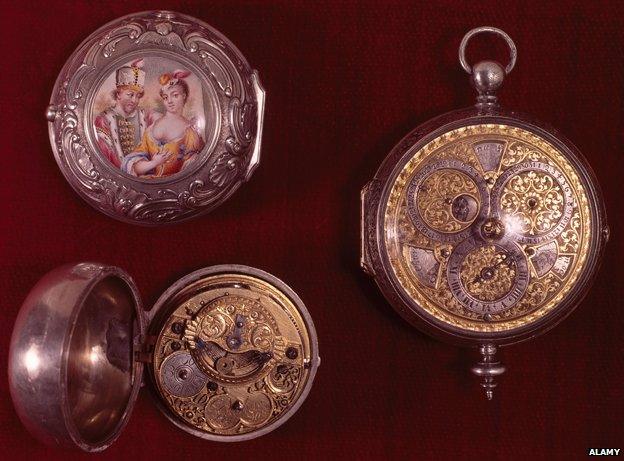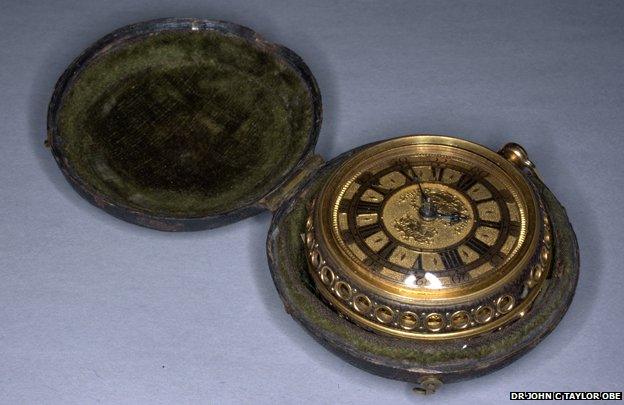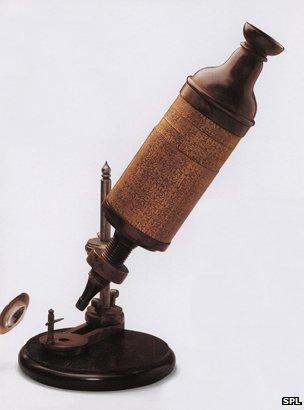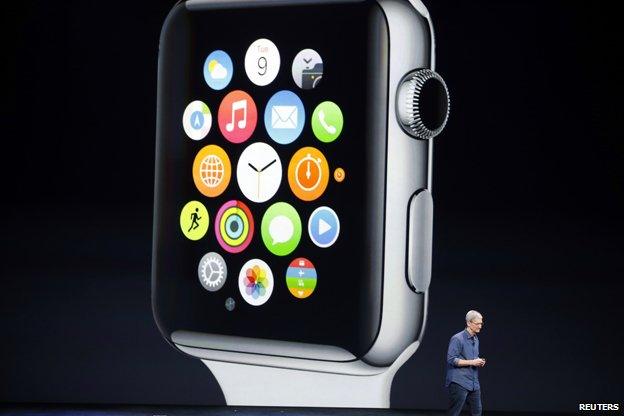A Point of View: How the world's first smartwatch was built
- Published

The pocket watch could be called the world's first "smart" device, and its development involved some of the greatest scientific minds of the 17th Century, writes historian Lisa Jardine.
The current issue of the magazine Antiquarian Horology dropped through my letterbox this week . It contains a short article about 16th Century pocket watches which begins: "Is this, or is it not, the world's oldest watch?" The watch in question is German, and the article announces an initiative to establish whether it pre-dates French, Italian, and Dutch watches of around the same date.
Those interested in horology seem perennially preoccupied with who got there first. Each modification to a clock or watch has to be attributed to an individual, whose technical savvy achieved ever greater precision in measuring the passage of time. The debates around precision timekeeping are a fascinating branch of the history of science (and I have to declare an interest here - Antiquarian Horology is the journal of the Antiquarian Horology Society, of which I recently became president).
Who first designed a more accurate timekeeper was once more than a matter of academic interest. In the late 17th Century, clock and watch design was part of national security. Navigation and mapping were both essential for the successful conduct of war - and England was involved in a sequence of wars against the French and the Dutch in this period. Star charts and nautical maps depended on observations made with one of the new long telescopes, and the time of each observation had to be accurately recorded. The person who could improve the accuracy of currently available clocks could make himself a handsome sum from manufacturing and marketing his state-of-the-art timekeeper.
So in the 1670s, Sir Jonas Moore, Surveyor General of the Royal Ordnance, and an accomplished practical mathematician, was preoccupied with clocks and watches. His interest was strictly tied to his military and naval responsibilities at the Ordnance Office, in the Tower of London. He was the person in charge of military supplies in time of war, and responsible for providing the best possible equipment for determining location to military and naval commanders.
In 1675 Moore became aware that the Royal Society was lobbying for the award of a patent to the Dutch scientist Christiaan Huygens, for a radically new design of watch - one regulated by a coiled hair spring - which brought its precision in line with current pendulum clocks, of the sort Jonas Moore was to commission and pay for himself for the new Observatory at Greenwich. Instead of having to cross the room from telescope to clock, an observer could now glance down from eyepiece to watch, producing a near-simultaneous correlation between reading and timing.
Huygens was a foreigner and (during the three 17th Century Dutch wars) an enemy alien. His competitor, who claimed to have invented the balance-spring-regulated watch first, was the London polymath Robert Hooke. Fortunately for Hooke, Sir Jonas Moore stepped in to the controversy (aghast, presumably, at the idea that the rights for so sensitive a piece of equipment should be granted to a Dutchman). It was proposed that the two men produce prototype watches, to be tested to see if their inventor's claims held up.

Pocket watches created by Thomas Tompion
Hooke set about proving that his balance-spring watch was superior to Huygens's (which he scornfully said, didn't even have a second hand). He had the best London clock-maker, Thomas Tompion, construct a watch to his own design which incorporated the revolutionary hair-spring regulator.
With the help of Moore, who had tutored the young Duke of York in mathematics, it was brought to the attention of the duke's brother, Charles II himself. Hooke and Tompion presented their prototype watch to the king for testing. It was delivered in early May 1675, its silver case inscribed in Latin: "Hooke invented this 1658. Tompion made this 1675."
Hooke recorded in his diary:
"With the King and shewed him my new spring watch, Sir J Moore and Tompion there. The king most graciously pleased with it and commended it far beyond Huygens's. He promised me a patent."

Thomas Tompion pocket watch dating from c1697
Over the months that followed, the king - who prided himself on his skills as a scientist, and had his own laboratory at Whitehall Palace - personally "tested" the Hooke/Tompion watch, reporting on its accuracy, and returning it for modification and correction when it ran slow. The king entered into the spirit of the contest, Hooke tells us, by keeping it "locked up in his closet".
Sir Jonas Moore was also provided with one of the top-secret watches to test. He passed his to John Flamsteed, a young astronomer who was later to become the first Astronomer Royal. Flamsteed observed that such a portable watch "being set by a corrected Pendulum" would be "of very good use in making astronomical observations".
He found that it performed well, differing by only a minute a day from his pendulum clock. He was annoyed, however, to be unable to examine the mechanism of the watch. As he explained to a friend, "Mr Tompion had filed off the spring that closes the watch so that I could not open it to see how the spring was fastened within."


Hooke's microscope
Robert Hooke (1635-1703)
One of the most distinguished minds of his age, but unfairly eclipsed by the fame of his contemporaries and sometime rivals Isaac Newton and Christopher Wren (and the fact that virtually no portrait of Hooke survives). Among his achievements:
Hooke's Law - that the extension of spring is proportional to the applied force
He wrote the first book on microscopy, Micrographia
His astronomical observations were some of the best seen at the time (there is a Hooke crater on the moon)
Architect, and surveyor for the City of London after the great fire of 1666

In the end, neither Hooke nor Huygens was granted an English patent for the balance-spring watch, since both watches kept less good time than their inventors had promised. Ultimately, what Moore was looking for was a timepiece that could keep accurate time under the adverse conditions of a ship at sea, to establish its longitude.
That question was not, of course, settled for almost another century. But both the Royal Observatory built in 1675, and the longitude committee set up by Charles II in the same year, were intended to help solve that vexed navigational problem. Neither Hooke's nor Huygens' watch proved up to the task.
With hindsight, though, both men deserve full credit for their remarkable improvements to pocket watches. It is hard for us to imagine not having access to the time.
The wristwatch - the first wearable timepiece - only replaced the pocket watch at the beginning of the 20th Century (though we are told that Elizabeth I was presented with an "arm watch" by Robert Dudley in 1571). Initially considered "unmanly", wrist watches were adopted during World War One, to give officers immediate access to the time when synchronising attacks.

Greenwich Observatory

The Greenwich Observatory was set up to tackle the problem of longitude
Commissioned in 1675 by Charles II, along with position of Astronomer Royal as observatory director, "to find out the so much desired longitude of places for the perfecting of the art of navigation"
Known as the location of the prime meridian (origin of Greenwich Mean Time), in Greenwich Park, in south-east London, the building was often given the title Flamsteed House, in honour of the first Astronomer Royal, John Flamsteed
Scientific work of the observatory was relocated in the 20th Century and the site is now a tourist attraction

And now we have a new generation of "wearables", heralded as a transformative technology, comparable in its impact to the all-pervasive mobile telephone. The Apple Watch is, of course, much more than a watch. It incorporates many features of a smartphone, available at the twist of its new knurled button. In addition it contains new sensors to monitor our heart rate and more accurately record our physical exertions. Over time it will connect to an ever-wider range of "health-related" products.
"It represents a new chapter in the relationship people have with technology" (reads the advertising blurb). "It's the most personal product we have ever made because it's the first one designed to be worn."
When Sir Jonas Moore was appraising Robert Hooke's balance-spring watch for its military usefulness, he was also aware that this navigational tool would enlarge the boundaries of the known world, and add to the growth of human knowledge. Precision watches would allow ships to sail further, more safely, and to bring back the unfamiliar and exotic.
Today we take for granted accurate timekeeping that 17th Century virtuosi could only dream of. We know exactly where we are on the earth's surface at all times. Today's wearables are all solipsistically about us as individuals - all there is to be known, or that matters to be known, is about ourselves:
"We all share the same hours, minutes and seconds" (Apple tells us). "But what happens during that time is different for everyone. So Apple Watch doesn't just keep accurate time. It allows you to see time in the ways that are most meaningful - and useful - to you."

The launch of the Apple watch earlier this month
Clocks and watches are, for me, the most seductive of the instruments lovingly crafted by London artisans during the 17th Century, when English clockmaking rose to pre-eminence. Each watch on display in the British Museum's clocks and watches galleries speaks to me of a world galvanised by scientific innovation, whose horizons were expanding through voyages of discovery and the new objects and ideas brought back.
I love technology. But am I alone in feeling that the Apple Watch is a symbol of the way we are looking increasingly narcissistically inwards towards ourselves, instead of boldly outwards towards a wider, better world?
A Point of View is broadcast on Fridays on Radio 4 at 20:50 BST and repeated Sundays, 08:50 BST
Subscribe to the BBC News Magazine's email newsletter to get articles sent to your inbox.